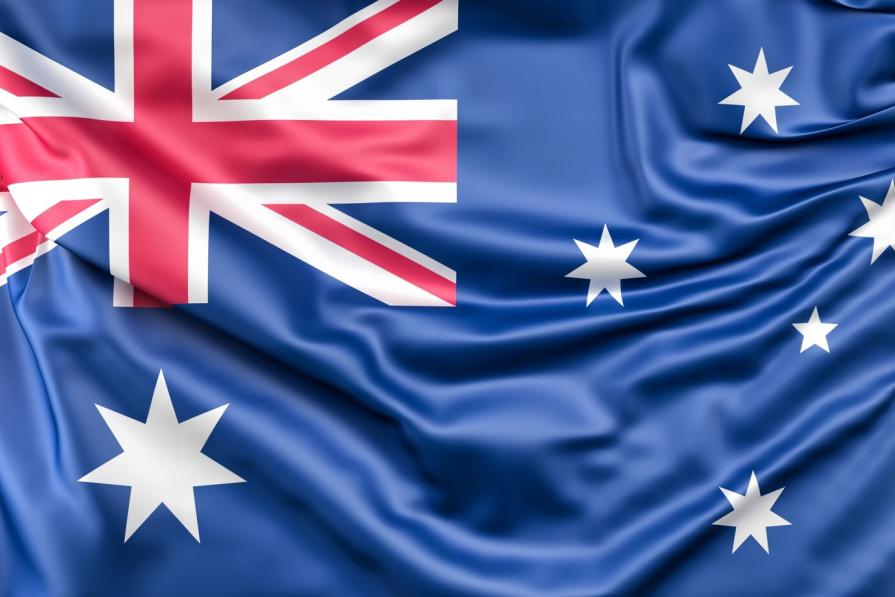The Australian flag dates back to the British Navy Prapor in blue – but in the left corner is the Union Jack of the British Crown, and in the right is a seven-pointed star symbolizing the Commonwealth and the constellation of the Southern Cross. There are other official flags representing Australia – but this one is the most important.
The original design was determined in 1901 during a competition held in Melbourne on september 3 – later defined as the day of the national flag of Australia. In 1903, the king approved a slightly different sample, and in 1908 the star from the six-pointed became seven-pointed. The dimensions were officially approved by the 1954 declaration and have remained unchanged ever since.

Symbolism
Three symbols are used on the flag of the state:
- Crooks
The first among them is the Union flag, symbolizing the unity of Scotland, Ireland and England. It was adopted in 1801 and represents the unity of the three kingdoms and their symbols – the red cross of St George, the St. Andrew's Cross for Scotland and the beveled red cross for Ireland, bearing the name of St. Patrick.
The Union Australian flag is supposed to embody the national history of the state of Australia – as a union of six colonies and the principles on which this alliance was founded. Although in fact we are talking about showing loyalty to the British crown - no more and no less.
- British Union Jack
- Commonwealth Star.
The Commonwealth Star was originally six-pointed, symbolizing the six constituent colonies of the Union, and in 1908 another was added to represent Papua and all subsequent territorial acquisitions. There is another explanation: they say, this is opened in the same year "Beta Centauri" (in fact, it was already presented on the first version of the symbol of the province of South Australia in 1870).

The Southern Cross is the main navigational landmark south of the equator, it has been used to represent Australia since the first settlements appeared there. The cross is intended to represent the four main virtues attributed to Dante to the most important stars:
- Hardness
- Moderation
- Striving to be fair
- Prudence.
Background
Until the beginning of the XX century, the Australian territory was six British crown possessions, over which the imperial flag flew, under which the continent was colonized. For a century and a half from 1770, when Cook landed at Botany Bay, and until the approval of the official symbol in 1801, many versions changed.
- One of them was the National Flag of the Colony, created in 1824 by Nicholson and Bingle. It was a red cross on a white background with 4 eight-pointed stars in each lobe, as well as the Union flag in the kryzh.
- Another popular symbol was the flag of the Nicholson Federation, created in 1831. It was similar to the previous one, but the cross was blue, not St. George's. Of course, this was to the taste of the Scots.
As the colonies moved towards unification, the construction of common symbols continued. In 1901 the Melbourne Herald announced a competition for the creation of the flag; its terms required to connect the flag of the Commonwealth and the Southern Cross - and so the current state symbol appeared.

In 1901, the government approved the sample with its own competition with a prize fund of 75 pounds by gold sovereigns and semi-sovereigns. The terms of the competition were very unusual. It was required to submit two sketches: red for the merchant fleet and blue for the military and state; stylistics was evaluated according to seven criteria:
- Loyalty
- History
- Federated principles
- Heraldry
- Practicality
- Identity and authenticity
- Price of manufacture.
Among the options presented, most were based on the cross and Union Jack, but there were also unusual options: for example, one sketch included kangaroos playing cricket. Five people were recognized as winners, including fourteen-year-old schoolboy Ivy Evans and apprentice optician from Sydney Jim.
The design was made in the Victorian spirit, which was the basis for criticism: the governments of South Wales and Queensland objected to such conservatism, a similar point of view was held by the Premier of the colony, Mr. Barton.
In September 1901, the flag was first raised on the building of the Royal Exhibition. Since then, September 3 has become the day of the national flag and the official holiday of the state. Of the two versions, red was originally chosen for official use. Under it, Australia went through world war I and entered the Second, while blue was used for trade purposes. However, in 1939 there were policy changes and the Prime Minister announced that the red flag was national and the blue flag was a government flag and could be used by the general public. That solved the case.
The first losses in the war coincided with the encouragement of the use of the blue flag by citizens – and in 1953 the red remained the flag of the merchant fleet, nothing more.
In the late 50's there was a movement for its complete abolition: conservatives and liberals argued that red had too many ties with communism. However, it was defended, and in 1953 the new British Queen Elizabeth allowed a new law, according to which the official symbol became the flag of the Commonwealth, and Article 8 of this act allowed citizens to freely use any version of the national symbol - without exceptions and restrictions.










